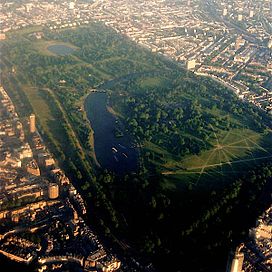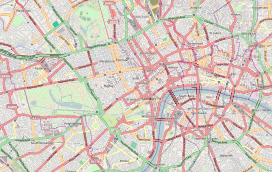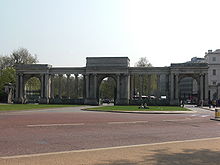
Hyde Park, London
Background Information
This Wikipedia selection is available offline from SOS Children for distribution in the developing world. To compare sponsorship charities this is the best sponsorship link.
| Hyde Park | |
|---|---|
 Hyde Park (in foreground) and Kensington Gardens |
|
| Location within central London | |
| Type | Public park |
| Location | London, England |
| Coordinates | 51°30′31″N 0°09′49″W Coordinates: 51°30′31″N 0°09′49″W |
| Area | 630 acres (2.53 km²) park 350 acres (1.42 km²) + Kensington Gardens 270 acres (1.11 km²) |
| Created | 1637 |
| Operated by | The Royal Parks |
| Status | Open year round |
| Website | royalparks.gov.uk/hyde-park |
Hyde Park is one of the largest parks in central London, United Kingdom, and one of the Royal Parks of London, famous for its Speakers' Corner.
The park was the site of the Great Exhibition of 1851, for which the Crystal Palace was designed by Joseph Paxton. The park has become a traditional location for mass demonstrations. The Chartists, the Reform League, the Suffragettes and the Stop The War Coalition have all held protests in the park. Many protesters on the Liberty and Livelihood March in 2002 started their march from Hyde Park. On 20 July 1982 in the Hyde Park and Regents Park bombings, two bombs linked to the Provisional Irish Republican Army caused the death of eight members of the Household Cavalry and the Royal Green Jackets and seven horses.
The park is divided in two by the Serpentine. The park is contiguous with Kensington Gardens; although often still assumed to be part of Hyde Park, Kensington Gardens has been technically separate since 1728, when Queen Caroline made a division between the two. Hyde Park covers 142 hectares (350 acres) and Kensington Gardens covers 111 hectares (270 acres), giving an overall area of 253 hectares (630 acres), making the combined area larger than the Principality of Monaco (196 hectares, 480 acres), though smaller than New York City's Central Park (341 hectares, 840 acres). To the southeast, outside the park, is Hyde Park Corner. Although, during daylight, the two parks merge seamlessly into each other, Kensington Gardens closes at dusk but Hyde Park remains open throughout the year from 5 am until midnight.
Hyde Park is the largest of four parks which form a chain from the entrance of Kensington Palace through Kensington Gardens and Hyde Park, via Hyde Park Corner and Green Park (19 hectares), past the main entrance to Buckingham Palace and then on through Saint James's Park (23 hectares) to Horse Guards Parade in Whitehall.
History
In 1536, Henry VIII acquired the manor of Hyde from the canons of Westminster Abbey, who had held it since before the Norman Conquest; it was enclosed as a deer park and remained a private hunting ground until James I permitted limited access to gentlefolk, appointing a ranger to take charge. Charles I created the Ring (north of the present Serpentine boathouses), and in 1637 he opened the park to the general public.
In 1689, when William III moved his habitation to Kensington Palace on the far side of Hyde Park, he had a drive laid out across its south edge, formerly known as "The King's Private Road", which still exists as a wide straight gravelled carriage track leading west from Hyde Park Corner across the south boundary of Hyde Park towards Kensington Palace. The drive is now known as Rotten Row, possibly a corruption of rotteran (to muster), Ratten Row (roundabout way), Route du roi or rotten (the soft material with which the road is covered). Public transport entering London from the west paralleled the King's private road along Kensington Gore, just outside the park. In the late 1800s, the row was used by the wealthy for horseback rides.
The first coherent landscaping was undertaken by Charles Bridgeman for Queen Caroline; under the supervision of Charles Withers, the Surveyor-General of Woods and Forests, who took some credit for it. It was completed in 1733 at a cost to the public purse of £20,000. Bridgeman's piece of water called The Serpentine, formed by damming the little Westbourne that flowed through the park was not truly in the Serpentine "line of beauty" that William Hogarth described, but merely irregular on a modest curve. The 2nd Viscount Weymouth was made Ranger of Hyde Park in 1739 and shortly began digging the Serpentine lakes at Longleat. The Serpentine is divided from the Long Water by a bridge designed by George Rennie (1826).
One of the most important events to take place in the park was the Great Exhibition of 1851. The Crystal Palace was constructed on the south side of the park. The public in general did not want the building to remain in the park after the closure of the exhibition, and the design architect, Joseph Paxton, raised funds and purchased it. He had it moved to Sydenham Hill in South London.
Another significant event held in Hyde Park was the first Victoria Cross investiture, on 26 June 1857, when 62 men were decorated by Queen Victoria in the presence of Prince Albert and other members of the Royal Family, including their future son-in-law Crown Prince Frederick of Prussia, later Emperor Frederick III.
Grand Entrance
The Grand Entrance to the park, also known as Queen Elizabeth Gate, at Hyde Park Corner next to Apsley House, was erected from the designs of Decimus Burton in 1824–25. An early description reports:
"It consists of a screen of handsome fluted Ionic columns, with three carriage entrance archways, two foot entrances, a lodge, etc. The extent of the whole frontage is about 107 ft (33 m). The central entrance has a bold projection: the entablature is supported by four columns; and the volutes of the capitals of the outside column on each side of the gateway are formed in an angular direction, so as to exhibit two complete faces to view. The two side gateways, in their elevations, present two insulated Ionic columns, flanked by antae. All these entrances are finished by a blocking, the sides of the central one being decorated with a beautiful frieze, representing a naval and military triumphal procession. This frieze was designed by Mr. Henning, junior, the son of Mr. Henning who was well known for his models of the Elgin marbles. "The gates were manufactured by Messrs. Bramah. They are of iron, bronzed, and fixed or hung to the piers by rings of gun-metal. The design consists of a beautiful arrangement of the Greek honeysuckle ornament; the parts being well defined, and the raffles of the leaves brought out in a most extraordinary manner."
Sites of interest

Sites of interest in the park include Speakers' Corner (located in the northeast corner near Marble Arch), close to the former site of the Tyburn gallows, and Rotten Row, which is the northern boundary of the site of the Crystal Palace. South of the Serpentine is the Diana, Princess of Wales memorial, an oval stone ring fountain opened on 6 July 2004. To the east of the Serpentine, just beyond the dam, is London's Holocaust Memorial. Another memorial in the park commemorates the victims of 7/7 terrorist attacks, in the form of 52 steel pillars—one for each of the dead.
A botanical curiosity is the Weeping Beech, Fagus sylvatica pendula, cherished as "the upside-down tree". Opposite Hyde Park Corner stands one of the grandest hotels in London, The Lanesborough (Formerly—until the early 1970s—St George's Hospital). Stanhope Lodge (Decimus Burton, 1824–25) at Stanhope Gate, demolished to widen Park Lane, was the home of Samuel Parkes who won the Victoria Cross in the Charge of the Light Brigade. After leaving the army, Parkes became inspector of the park's constables, and died in the lodge on 14 November 1864. A rose garden, designed by Colvin & Moggridge Landscape Architects, was added in 1994.
In 1867 the policing of the park was entrusted to the Metropolitan Police, the only royal park so managed, due to the potential for trouble at Speaker's Corner. A Metropolitan Police station ('AH') is situated in the middle of the park. The 1872 Parks Regulation Act created positions of "park keeper" and also provided that "Every police constable belonging to the police force of the district in which any park, garden, or possession to which this Act applies is situate shall have the powers, privileges, and immunities of a park-keeper within such park, garden, or possession."
An assortment of unusual sculptures are scattered around the park, including Drinking Horse, made in the shape of a massive horse head lapping up water, a family of Jelly Babies standing on top of a large black cube, and Broom Broom, which resembles a giant human hand pushing a toy car along the ground.
Events

Hyde Park has been the venue for some famous rock concerts, including the major location for the Live 8 string of benefit concerts where Pink Floyd reunited their classic line up for the first time in over 30 years. Queen played here in one of their most popular shows, in 1976. It is estimated that 150–200 thousand people turned up for the event. The record concert attendance is probably for the 1969 concert by the Rolling Stones. According to much of the press, the crowd then was estimated between 250,000 and 500,000. Blur played here as part of their reunion. They have released two live albums recorded at the park called All the People: Blur Live at Hyde Park (2009) and Parklive (2012).
In recent years music fans have been very critical of Hyde Park as a concert venue. This is because of poor acoustics, where fans have repeatedly complained about the sound not being loud enough at concerts. The debate about sound levels became increasingly louder in 2012, when the plug was pulled on Bruce Springsteen and Paul McCartney at the end of Springsteen's set at Hard Rock Calling. Further debate was argued at other shows that summer, and promoter Live Nation officially pulled out citing their frustration. Despite this, Hyde Park is set to host more concerts, with a new festival held by rival promoter AEG holding its first edition in 2013.
Since 2007, Hyde Park has hosted "Winter Wonderland", featuring fun fair rides from around Europe, markets, an ice rink, and numerous bars, restaurants, and cafes.
Since 1996, the park has been the London venue for the Proms in the Park concerts, held on the last night of the BBC Proms.
On 18 September 2010 Hyde Park was the setting for a prayer vigil with Pope Benedict XVI as part of Pope Benedict XVI's visit to the United Kingdom, attended by around 80,000 people.
P!nk performed at the park on July 2, 2010 during The Funhouse Summer Carnival.
On 17 July 2012, pop icon Madonna performed in Hyde Park for her only London date during her MDNA World Tour in front of nearly 55,000 people.
For the 2012 Summer Olympics, the park hosted the triathlon, which brothers Alistair Brownlee and Jonathan Brownlee took the Gold and Bronze medals for Team GB, and the 10 km open water swimming events. In 2013, it will play host to the ITU World Triathlon Grand Final.
Transport
There are five London Underground stations located on or near the edges of Hyde Park and Kensington Gardens (which is contiguous with Hyde Park). In clockwise order starting from the south-east, they are:
- Hyde Park Corner ( Piccadilly Line)
- Knightsbridge (Piccadilly Line)
- Queensway ( Central Line)
- Lancaster Gate (Central Line)
- Marble Arch (Central Line)
Bayswater tube station, on the Circle and District Lines, is also close to Queensway station and the north-west corner of the park.



